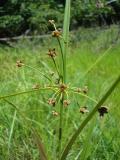
Featured Plants
There are over six hundred rare and imperiled plant species in Pennsylvania. In some cases, these species are naturally rare, usually because they are adapted to habitats that are rare and geographically restricted. Other species were once more common, but have declined in abundance, geographic range, or both. Some of the highest priority rare plants in Pennsylvania are featured below. Visit PNHP's website for additional information.
Northeastern Bulrush (Scirpus ancistrochaetus)
Only 70-80 populations exist in Pennsylvania, which has the largest number of occurrences. The decline of this species is attributed to multiple threats: degradation of habitat from road construction and upland runoff, destruction by off road vehicles, and conversion of land for other uses.
Small-whorled Pogonia (Isotria medeoloides)
The small whorled pogonia is a delicate orchid with a stout, upright stem eight to ten inches high, topped with a whorl of four to six (usually five) leaves. The small whorled pogonia is considered our rarest orchid. Only three populations are known in Pennsylvania.
Largeflowered marshallia (Marshallia grandiflora)
Largeflowered marshallia grows in wet forests or meadows and on stream banks throughout central Appalachia. Largeflowered marshallia is known to occur in only 11 watersheds within its range, and many of these watershedwide occurrences are really collections of several very small, widely scattered populations. It tends to occur in moist to wet sandy soil, in sandy/cobbley alluvium or in bedrock crevices along the flood-scoured banks of large, high-gradient rivers in the central Appalachians. The species is also reported from rocky lake shores, creek banks, bluffs and flood plains.


